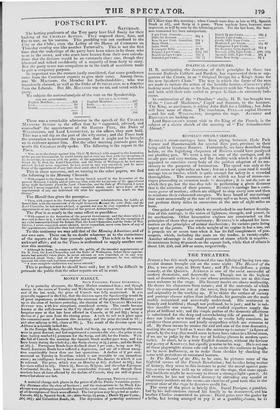RUSSELL'S .STEAM - CARRIAGE.
Rossris.'s steam•carriages have been plying between Hyde Park Corner and Hammersmith for several days past, previous to their being sold by GEORGE ROBINS. Fortunately, we have described them before, or the highflying eloquence of ROBINS would have paralyzed our plodding pen. We went a trip on one of the carriages, and its steady pace and easy motion, and the facility with which it is guided appeared to convince every body of the perfect adaption of its ma- chinery to the purposes of locomotion. The speed was only at the rate of seven or eight miles an hour ; but on a hard, even road it would average ten or twelve, which is quite enough for safety in a crowded thoroughfare. The enormous rate at which we hear of steam-car- riages proceeding on common roads is deceptive ; it is not the rate at which they go, but the time they take in performing a given distance that is the criterion of their powers. RUSSELL'S carriage has a conti- nuous power of motion ; others are obliged to stop every now and then to reinforce their exhausted energies. We have heard of one carriage that went occasionally at the rate of twenty miles an hour, which could not perform thirty miles in succession at the rate of eight miles an hour.
One point of superiority which we overlooked in our former descrip- tion of this carriage, is the union of lightness, strength, and power, in its mechanism. Other locomotive engines are constructed on the principles of those that arc stationary; Russet.es is adapted for loco- motion on the principles of animal mechanism ; its various parts being largest at the joints. The whole weight of its engine is but a toil, yet it propels six or seven tons when it has its full complement of pas- sengers, which, including the seats on the tender, is twenty-eight. Another advantage is the small pressure of steam which it requires : its maximum being 40 pounds on the square inch, while that of others is about 150, 250, and 500 or more, respectively.
























 Previous page
Previous page